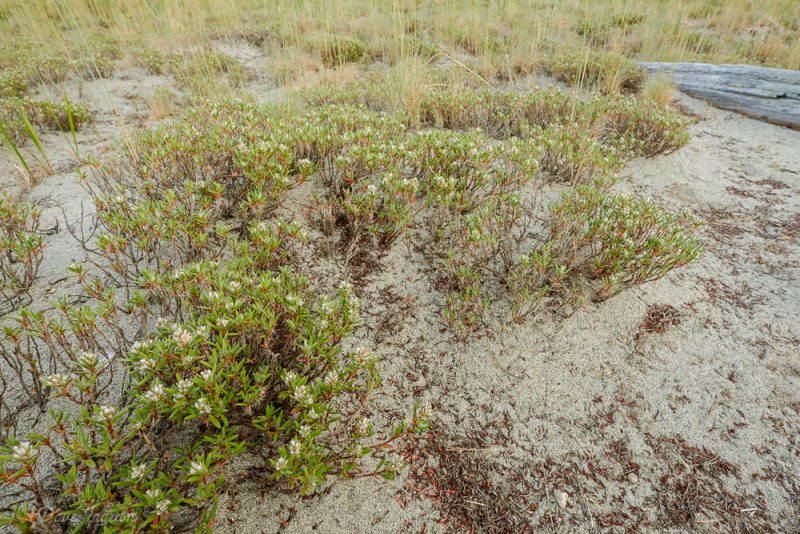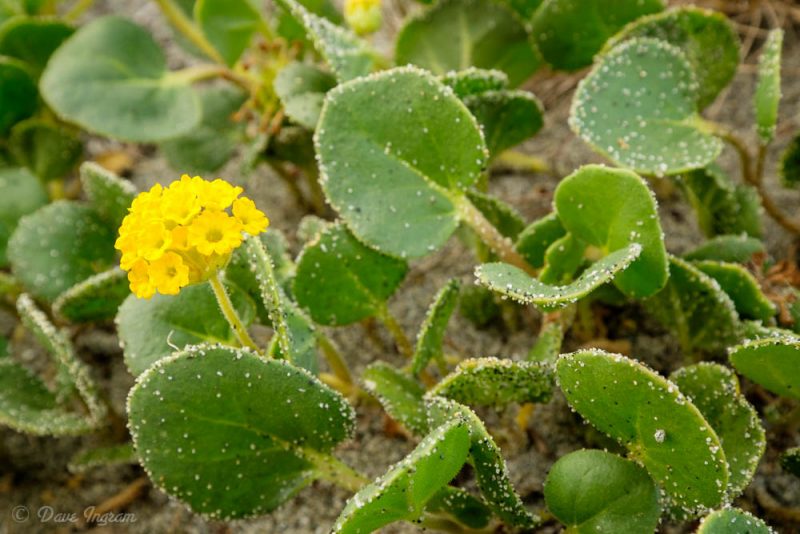It has been too long since I’ve checked out the plants in the spectacular dunes at Goose Spit. A number of specialized plants grow in these dunes—yellow sand verbena (Abronia latifolia) and black knotweed (Polygonum paronychia) are prolific. With a little effort, other interesting plants can be found as well.

My intention was to photograph the yellow sand-verbena. Large mats of the low, sand loving plant grow in the foreshore dunes along the main access road and parking areas, but the better patches are further along the spit. Given the time of day (early evening), I thought that there might be an outside chance to find sand-verbena moth (Copablepharon fuscum) as well. I knew that this very rare, red-listed moth is found only in association with its host plant, the yellow sand-verbena. The sand dunes at Goose Spit are one of only 10 known locations where this moth has been found along the shores of the Salish Sea.

After a couple of hours the light was beginning to fail and the wind was picking up making flower photography particularly challenging. It was then that I noticed a small, pale moth nectaring on the flower of a yellow sand verbena—I couldn’t believe my luck, a sand-verbena moth!

The connection between the moth and yellow sand-verbena is very strong. The moth depends exclusively on the sand-verbena in all stages of its life-cycle except for when it is pupating. Adults live a brief one to three weeks. During this time (typically May/June, with a peak in mid-June that coincides with the flowering of the yellow sand-verbena) the adults nectar on the flowers of the sand-verbena, mate, and lay eggs. The eggs hatch in approximately two weeks and the larva feed at night on the flowers and leaves of the sand-verbena for the rest of the summer. Rather than overwintering as pupae, the larva enter a period of dormancy called diapause in the early fall. They awaken in the early spring and continue to feed on leaves in preparation for pupation. Pupation occurs in April and May and takes place underground in the sand.

The sand-verbena moth is extremely well suited to its habitat and blends in well with the sand and dried brown vegetation. If I hadn’t initially seen the moth in the open on the flower, it would have been extremely difficult to find it nestled close to the sand on the leaves of the sand-verbena. I watched as it flew from the flower and disappeared at the base of one of the plants a short distance away. Once it had landed in a protected, less-visible location, it was very cooperative, not moving much as I spent a short time photographing it.

As a red-listed species, the future of the sand-verbena moth is precarious. It depends on a single host plant (yellow sand-verbena) which grows in a specific habitat. Coastal dune ecosystems on Vancouver Island are vulnerable to habitat degradation due to human recreation and development, rising sea levels associated with climate change, displacement of sand-verbena by invasive introduced species, and the use of insecticides and herbicides that inadvertently may kill the moth. In British Columbia it has been reported in only three locations—Goose Spit, Sandy Island (near Denman Island), and three associated sites near Sidney, Saanich Peninsula. The total area of the 5 sites is around 15 hectares. It is also found along the shores of Puget Sound in Washington.
The dunes at Goose Spit are an extremely interesting and fragile place. Please use care if you decide to visit and minimize your impact. If you’re lucky and time it right, you might just see a sand-verbena moth as well!
Read More:
- Xerces Society: Sand-verbena Moth
- Species at Risk: Sand-verbena Moth
- COSEWIC: Sand-verbena Moth
- BC Species and Ecosystems Explorer